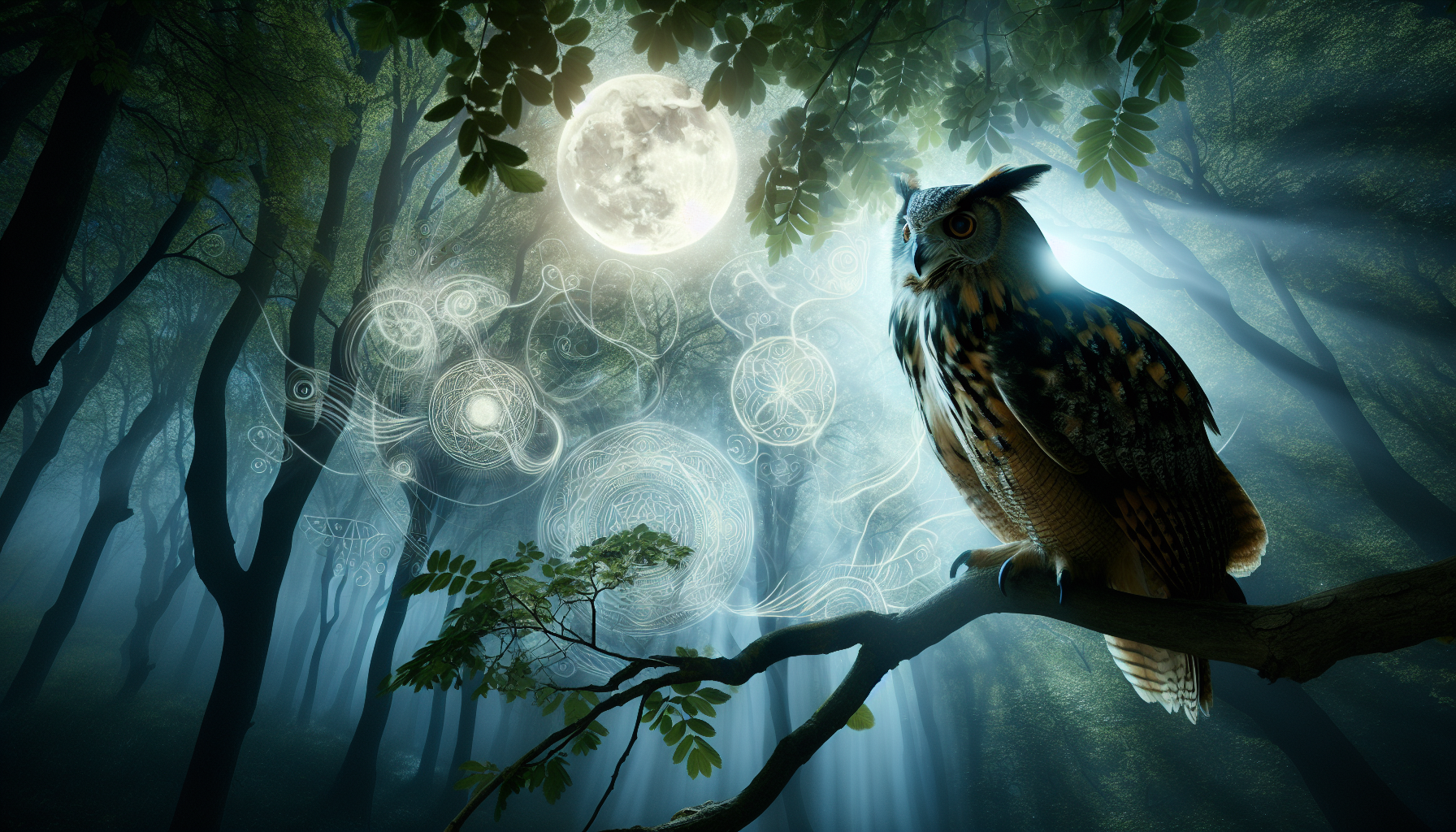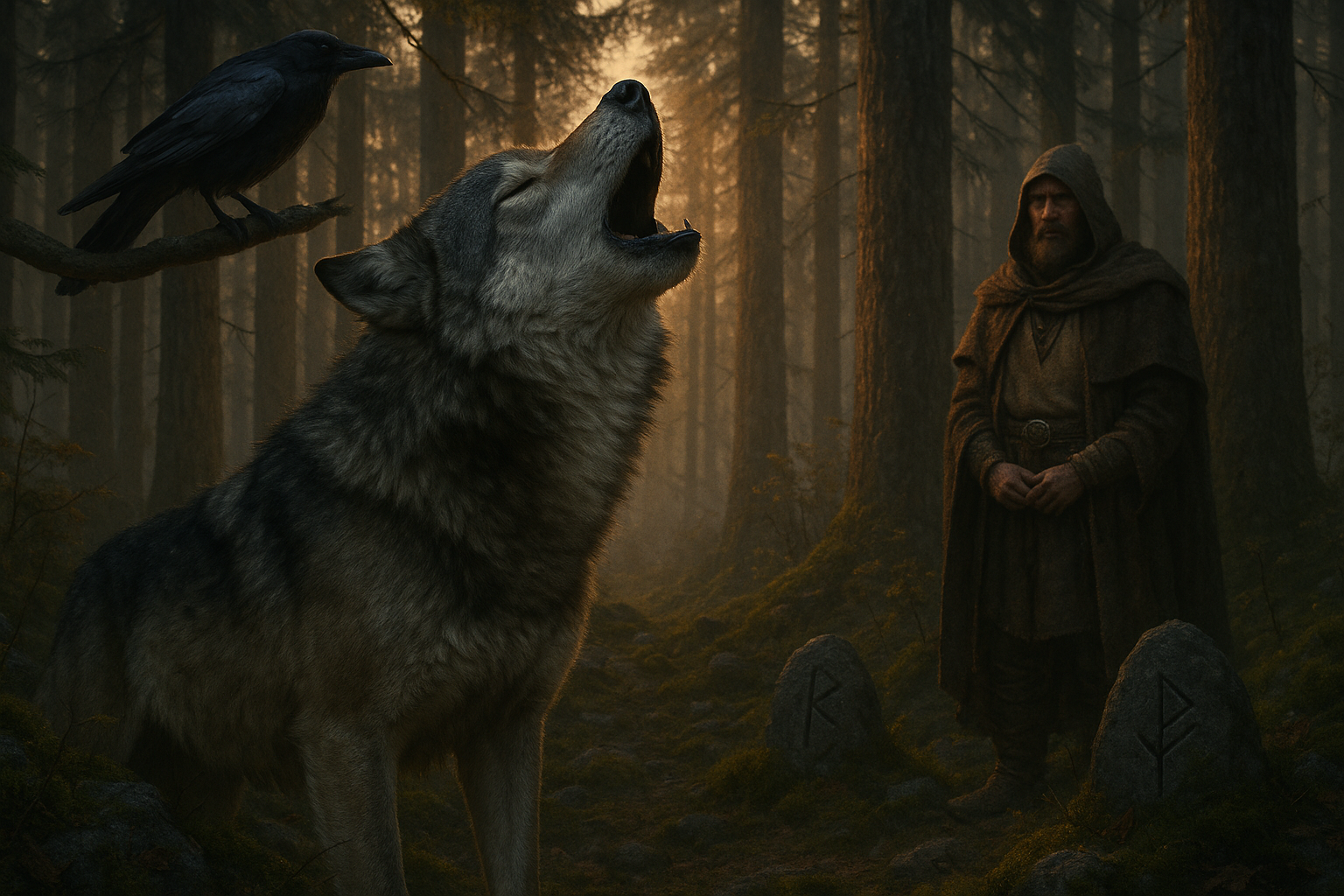In the stillness of the night, when the world is cloaked in darkness and silence reigns supreme, the haunting call of an owl can be both mysterious and enchanting. For centuries, these nocturnal birds have captivated human imagination, their eerie hoots and haunting screeches echoing through the woods, sparking curiosity and sometimes even fear. But beyond the spine-tingling allure of their calls lies a world of hidden messages and ancient omens waiting to be unraveled. 🦉 What are these mysterious calls saying? What secrets do they hold about the owls themselves, and what do they reveal about the natural world around us?
Owls, with their distinctive calls, have been subjects of myth, folklore, and scientific study across various cultures. Their voices are not just random sounds piercing the night; they are complex communications that can indicate territory, signal mating intentions, or serve as warnings to potential predators and rivals. Each species has its unique repertoire of calls, ranging from the classic “hoo-hoo” of the Great Horned Owl to the eerie screeches of the Barn Owl. By delving into these vocalizations, we can gain insights into the behavioral patterns of these magnificent creatures and their role in different ecosystems. Moreover, throughout history, owl calls have been considered omens, either of doom or wisdom, influencing human beliefs and superstitions. In this article, we will journey through the mysterious world of owl calls, exploring their biological significance and cultural impact.
Throughout this comprehensive exploration, we will decode the intricate language of owl calls, examining the various types of sounds and their meanings. We will also delve into the fascinating myths and legends surrounding these calls, tracing how they have shaped human culture and perception of owls over time. From the haunting tales of ancient Greece, where owls were seen as symbols of wisdom and protectors of the Acropolis, to the chilling superstitions of medieval Europe, where their calls were often considered harbingers of death, we will uncover how these interpretations have evolved. 🌌 Furthermore, we will highlight the latest scientific research on how owls communicate and the ecological importance of their vocalizations. By the end of this article, you’ll not only have a deeper appreciation for these enigmatic birds but also a better understanding of the natural symphony that unfolds each night under the starry sky.
The Enigmatic World of Owl Calls: An Introduction
Owls have long captured the human imagination, from ancient mythology to modern pop culture. Their mysterious calls pierce the silence of the night, leaving many to wonder about the meanings and messages hidden within these haunting sounds. For centuries, different cultures have attributed various omens to owl calls, associating them with both good and ill fortune. But beyond folklore, scientific research has begun to unravel the true purpose and complexity behind these enigmatic calls, providing insights into owl behavior, communication, and ecology.
To truly understand the significance of owl calls, it’s essential to delve into the biology and ecology of these nocturnal birds of prey. Owls belong to the order Strigiformes, which is divided into two families: Tytonidae (barn owls) and Strigidae (typical owls). These birds are known for their exceptional hunting abilities, aided by their acute sense of hearing and specialized feathers for silent flight. Their calls play crucial roles in their survival, serving purposes such as territory defense, mate attraction, and predator deterrence.
The sounds owls produce vary widely among species, from the iconic hoots of the great horned owl to the eerie screeches of the barn owl. Each species has its own unique repertoire, and these calls can be further categorized based on their function. Understanding these categories helps in deciphering the messages owls convey through their calls. Furthermore, researchers have employed various technologies, such as bioacoustic monitoring and sound analysis, to study owl calls in detail, opening new avenues for wildlife conservation and management.
The Functions of Owl Calls: Communication and Survival
Owl calls serve a variety of functions, each essential to the bird’s survival and reproduction. At the most basic level, owl calls are used for communication between individuals. These vocalizations can convey information about an owl’s identity, sex, and even its emotional state. In the wild, these sounds play a pivotal role in maintaining social structures and interactions.
One primary function of owl calls is territory establishment and defense. Many owl species are territorial, and their calls serve as auditory markers that define the boundaries of their domain. By vocalizing, owls can avoid physical confrontations with rivals, which can be energetically costly or dangerous. Additionally, calls can deter potential intruders by signaling the presence of a resident owl, thereby maintaining the stability of the territory.
Mating and reproduction also heavily rely on vocal communication. During the breeding season, male owls often increase their calling activity to attract females. These courtship calls are designed to showcase the male’s fitness and desirability as a mate. Females, in turn, may respond with their own calls, facilitating pair bonding. This exchange of vocalizations helps ensure successful reproduction, as it enables owls to locate each other and coordinate nesting activities. 📣
Case Study: The Great Horned Owl
The great horned owl (Bubo virginianus) provides an excellent example of how vocalizations are integral to an owl’s life. Known for their distinctive “hoot,” these owls use a variety of calls for different purposes. Their hoots are primarily used for territory defense and can be heard from several kilometers away. These calls also help in identifying individuals within a population, as each owl has a slightly different pitch and rhythm to its hoots.
During the breeding season, great horned owls engage in duets, where males and females call to each other, reinforcing their pair bond and synchronizing their reproductive activities. These duets serve as a public display of their partnership and can discourage rival owls from encroaching on their territory.
In addition to hoots, great horned owls produce a range of other sounds, such as screeches and barks, which serve different functions, such as signaling distress or alerting their mate to potential threats. These diverse vocalizations highlight the complexity and richness of owl communication, offering insights into their behavioral ecology.
Decoding the Hidden Messages: What Owls Are Really Saying
Decoding owl calls requires an understanding of the context in which they are used. While some calls are straightforward, such as those for territory marking or mate attraction, others can be more subtle and complex. Researchers have employed advanced audio analysis techniques to dissect these calls, revealing the nuances and variations that convey specific messages.
For instance, owls can modulate the frequency, duration, and intensity of their calls to convey different meanings. A call’s frequency might indicate the caller’s size or age, with lower frequencies often associated with larger, more dominant individuals. Duration can signal the urgency or importance of a message, while intensity might reflect the caller’s emotional state.
By analyzing these parameters, scientists can interpret the information owls communicate, providing insights into their social dynamics and interactions. This understanding is crucial for conservation efforts, as it enables researchers to monitor owl populations and assess their health and stability. 📊
Comparative Analysis: Owl Calls Across Species
The diversity of owl calls is astounding, with each species exhibiting its own unique vocal signature. The table below provides a comparative analysis of owl calls across several common species, highlighting the differences in call types, frequencies, and purposes.
| Species | Call Type | Frequency Range (Hz) | Main Purpose |
|---|---|---|---|
| Great Horned Owl | Hoot | 200-800 | Territory Defense |
| Barn Owl | Screech | 300-1000 | Mate Attraction |
| Eastern Screech-Owl | Trill | 500-1500 | Mate Communication |
As illustrated in the table, different owl species have adapted their calls to suit their ecological needs and social structures. These adaptations reflect the evolutionary pressures faced by each species, highlighting the importance of vocal communication in their survival.
Omens and Folklore: Cultural Perspectives on Owl Calls
Owl calls have held symbolic meanings across various cultures throughout history. In many societies, these calls are seen as omens or messages from the spiritual world. For instance, in ancient Greek mythology, the owl was associated with Athena, the goddess of wisdom, and its call was believed to be a sign of her presence or guidance.
In contrast, other cultures have viewed owl calls as harbingers of ill fortune. In some Native American traditions, the call of an owl was considered a warning of impending danger or death. Similarly, in parts of Africa and Asia, owl calls were often linked to witchcraft or malevolent spirits, instilling fear and superstition among the populace.
Despite these differing interpretations, owl calls have universally captured the human imagination, inspiring art, literature, and mythology. Their enigmatic nature and nocturnal habits have only added to their allure, making them symbols of mystery and the unknown. 🎭
The Role of Owl Calls in Modern Media
In today’s world, owl calls continue to fascinate and inspire. They are frequently used in films and television to create an atmosphere of mystery or foreboding. The distinctive sound of an owl hooting in the night is often employed to heighten suspense or signal a pivotal moment in a story.
Moreover, owl calls have found their way into music and sound design, where they are used to evoke emotions and set the mood. These calls, with their haunting quality, resonate with audiences, tapping into deep-seated cultural associations and primal instincts.
For those interested in exploring the world of owl calls further, numerous documentaries and online resources are available. One recommended video is “The Secret Language of Owls” by Nature on PBS, which delves into the fascinating lives of these birds and the significance of their calls. Watch the video here: The Secret Language of Owls – Nature on PBS.

Conclusion
Conclusion: Unlocking the Mysteries of Owl Calls: Decoding the Hidden Messages and Omens
Throughout our exploration of the intriguing world of owl calls, we’ve uncovered layers of meaning that stretch far beyond their hauntingly beautiful sounds. Owls, with their enigmatic calls, have fascinated humans for centuries, serving as both literal and symbolic messengers in our natural and cultural landscapes.
In the initial sections, we delved into the biological and ecological aspects of owl calls. We learned that these calls are not mere sounds but complex communication tools that serve various purposes, from territory defense to mate attraction. Owls possess a unique vocal anatomy that allows them to produce a wide range of sounds, each with distinct meanings. This remarkable ability highlights the sophistication of their communication system and underscores the importance of sound in the animal kingdom.
Transitioning to the cultural significance, we uncovered the diverse interpretations and beliefs surrounding owl calls across different societies. In many cultures, owls are seen as omens or bearers of significant messages. Whether viewed as symbols of wisdom, harbingers of death, or protectors, these birds have left an indelible mark on human folklore and mythology. The stories and legends we explored reveal a deep connection between humans and owls, reflecting our enduring fascination with these nocturnal creatures.
Moreover, we examined the scientific advancements that have enabled us to better understand and decode owl calls. With the advent of modern technology, researchers can now analyze these calls with greater precision, unveiling insights into owl behavior and communication that were previously inaccessible. This scientific perspective not only enhances our knowledge but also emphasizes the importance of preserving owl habitats, ensuring that these mystical sounds continue to echo through our ecosystems.
The importance of understanding owl calls extends beyond mere curiosity. By deciphering these messages, we gain valuable insights into the health and dynamics of our ecosystems. Owls, as apex predators, play a crucial role in maintaining ecological balance. Their presence and vocalizations can indicate the state of biodiversity in a given area, serving as vital indicators for conservation efforts.
As we conclude our journey into the world of owl calls, it is essential to reflect on the broader implications of our discoveries. Owls, with their mysterious calls, remind us of the wonders of nature and the intricate web of life that surrounds us. They encourage us to listen more closely, not only to their calls but also to the myriad of voices in our natural environment, urging us to become more attuned to the world we inhabit.
We invite you, dear reader, to take these insights and apply them in your own life. Whether you’re a seasoned birdwatcher, a curious nature enthusiast, or someone new to the world of owls, there’s always more to learn and explore. Consider visiting local wildlife reserves or participating in citizen science projects that focus on bird conservation. Your involvement can make a significant impact on preserving these incredible creatures and their habitats.
Additionally, we encourage you to share this article with friends and family who might be intrigued by the mysteries of owl calls. Engaging in conversations about nature and wildlife can foster a deeper appreciation for the environment and inspire collective action toward conservation.
Finally, we would love to hear your thoughts and experiences. Have you ever encountered an owl in the wild? What did its call mean to you? Share your stories in the comments below and join the conversation. Together, we can continue to unravel the mysteries of the natural world, one call at a time. 🌿🦉
For further reading and exploration, consider visiting these reputable sources:
Thank you for joining us on this fascinating journey into the world of owls. We hope you leave inspired, informed, and eager to explore the wonders that nature has to offer.
Toni Santos is a sound storyteller and folklore researcher whose creative path bridges the mystical and the biological through the lens of bioacoustic folklore. With an ear attuned to the voices of nature, Toni explores how ancient cultures interpreted birdsong, forest echoes, and animal calls—not as noise, but as messages, omens, and myths encoded in sound.
Rooted in a passion for both natural science and ancestral lore, his work uncovers the forgotten connections between ecosystems and oral traditions. From the whispered warnings in owl cries to the songs of frogs heralding rain, Toni’s narratives evoke a time when humans listened to nature with reverence and meaning.
Drawing on a background in ecological arts and auditory storytelling, Toni merges field recordings with mythic imagery, turning natural sounds into cultural artifacts of wonder. His stories do more than entertain—they restore a way of hearing the world that blends intuition, memory, and deep listening.
As the creative force behind Vizovex, Toni offers sonic tales, symbolic soundscapes, and research-based reflections that help others rediscover the sacred language of the wild.
His work is a tribute to:
The mythological significance of animal and elemental sounds
Ancient practices of listening for meaning in nature
The spiritual dialogue between humans and soundscapes
Whether you’re a folklorist, an acoustic ecologist, or a curious listener, Toni invites you into a world where the forest speaks, and every chirp, croak, and howl carries a story—one echo, one legend, one call at a time.



